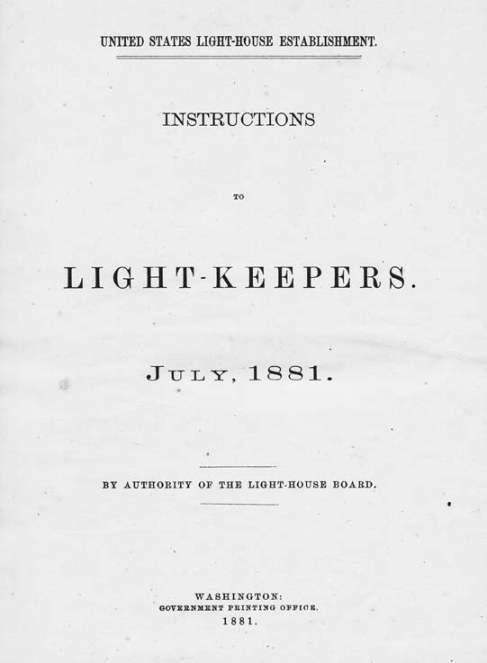
An email made its way across staff computers today bringing to our attention a new post on the Lighthouse History blog. Its a summary of the Instructions to Light-Keepers, a formal set of guidelines set by the U.S. government’s Light-House Board for Lighthouse Keepers across the country. Its a great read so I thought I’d bring it to folks attention on our own blog.
Some highlights from Lighthouse History:
The 1881 Instructions began, “The Keeper is responsible for the care and management of the light, and for the station in general. He must enforce a careful attention to duty on the part of his assistants; and the assistants are strictly enjoined to render prompt obedience to his lawful orders.” Absences had to be communicated to those left in charge and reported to the inspector. “Light-keepers may leave their stations to attend divine worship on Sundays, to procure needful supplies, and on important public occasions.”
“Watches must be kept at all stations where there is an assistant. The keeper on watch must remain in the watch room and give continuous attention to the light while he is on duty. When there is no assistant, the keeper must visit the light at least twice during the night between 8 p.m. and sunrise; and on stormy nights the light must be constantly looked after.”
A keeper was expected to understand how to operate the apparatus and use strict economy in the use of his supplies: “He must be careful to prevent waste, theft, or misapplication of light-house property.” Quantities of oil and other supplies used each day had to be recorded.
“Light-keepers must not engage in any traffic on light-house premises, and they must not permit it by any one else. They must not carry on any business or trade elsewhere which will cause them to be often absent from the premises, or to neglect, in any way, their proper duties.”
Visitors to the light station were to be treated courteously and politely, but not allowed to handle the apparatus or carve their names on the lantern glass or tower windows. Intoxicated persons were to be removed “by the employment of all proper and reasonable means.”
I always love to see references to shipwrecks, and the Keeper’s duty towards shipwrecks and survivors. We also are interested in how Keepers used boats on the premises. So I love the following tidbit:
Shipwrecks were to be reported promptly to the inspector. “It is the duty of light-keepers to aid wrecked persons as far as lies in their power.” Precautions had to be taken against fire; fire-buckets were to be kept filled and ready. Burning mineral oil, or kerosene, was to be extinguished with sand or ashes rather than water.
Boats were furnished at stations where they were “necessary for communication with the mainland, to obtain household supplies, etc.” They were to be used only for light-house purposes; “the boats must not be used for freighting, wrecking, fishing with seines, ferrying, or for carrying goods or passengers for hire.”
To check out the entire blog post, click here. Its worth a read!

